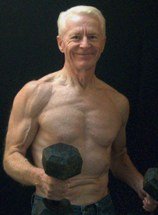| Back to Back Issues Page |
 |
|
The Gray Iron Fitness Newsletter, Issue #301. Senior Life Lessons. June 15, 2021 |
Hi
June 15, 2021
In this newsletter . . . Senior Life LessonsOne day my dog and I were out for a walk to a mailbox and, coincidentally, the postman’s truck was sighted just ahead of us. I decided to step up our pace and catch him. But each time we’d almost reach his truck, he would pull away to his next stop. This went on for a few blocks until we finally caught up.As the postman got out of his truck I noticed how elderly he appeared, white-haired and well past the usual retirement age. I kidded him about our chasing down his truck. He remarked that both his knees had been surgically repaired. I told him that he looked quite nimble getting in and out of the truck and walking up the driveways. “That’s the only reason I still come to work,” he said. “I could have retired some time ago. But if you don’t keep moving, it’s all over.” In those three short sentences, he had healthy aging figured out. Walk, or jog, or bike, or swim, or work in the garden. Whatever holds your interest. But keep moving. Add some resistance exercise and stretching and stay as fit as possible for as long as possible. A popular men’s magazine broke down by decades suggested exercise guidelines for people as they age. It wasn’t one of the steroid-bodybuilding publications but a men’s magazine of reasonableness. My only quarrel with the article is that more emphasis might have been placed on the word “guidelines.” Certainly, workouts must evolve and change from decade to decade, but rigid formats usually aren't the best way to go. And the magazine had broken it down to exact exercises, sets, and reps to do in each decade, beginning in your 20s, then your 30s, 40s, 50s, 60s. (The 70s on up weren’t mentioned.) As mechanical as their guidelines sounded, I shouldn't be too critical, as long as the advice is not taken as absolute. Everyone’s abilities and needs may not follow the same trajectory while moving from one decade to the next. Other factors, too, such as injuries or illnesses, must be taken into account when adjusting programs. In my own case, I saw little difference in what I could do in my 50s. Capacity changes in my 60s also were quite gradual. Still, looking back at my training records, I can see there was some loss in strength as well as a need for more recovery time after workouts. Turning 70, I began noticing a steeper decline. But that's me. The need for adjustments may come at different stages for each of us. Now in my mid-eighties, abbreviated workouts with resistance bands have become more sensible. I gave up one-rep-maximum lifts with free weights years ago. Seniors sending their blood pressure through the roof with do-or-die efforts isn’t smart. When the great bodybuilder Steve Reeves moved into his 60s and 70s, he still weight trained three days per week. But he cut back his sets from three or four to two, and used lighter weights, doing 15 to 25 reps, depending on which body part he was working. He isn’t a bad example to follow. So keep moving. That’s the key. Make use of intelligent guidelines like those at Senior Exercise Central. Then make adjustments according to your own needs. For senior beginners, a good, solid place to start is right here. And if you can’t catch up with the postman’s truck, that’s probably okay. The fact that you are out there moving is the important thing. Stay healthy. Stay fit. Logan Are you on Facebook?Check out the Senior Exercise Central page at . . . https://www.facebook.com/GrayIronFitness
I search the Internet for senior health and fitness items. If you like what you see, please click the Like button. It helps me. Spread the word. If you like the newsletter, we're making it easy to share it Newsletter Policy The Gray Iron Fitness Newsletter is a free publication sent twice monthly to subscribers. The purpose is to provide honest and realistic fitness information for people age 50 and above. I have never been paid or received compensation of any kind to write a positive review or endorse a product. If I say that I personally use a product or service, it is because I find value in it and have paid for it with my own money. Like newspapers, magazines and television, this newsletter and my web site contain advertising and marketing links. Naturally, I am compensated for these. The newsletter and web site provide information to help users establish and maintain a fitness lifestyle. But fitness information is not the same as fitness advice, which is the application of exercise and dietary practices to an individual's specific circumstances. Therefore, always consult with your physician for assurance that fitness information, and your interpretation of it, is appropriate for you. Your comments and questions are always appreciated. Simply click on the "Reply" bottom. |
| Back to Back Issues Page |